
Trump and the Multipolar Moment
The policy proposals of President Donald Trump illuminate signs of an emerging multipolar structure. In particular, Trump’s remarks about Putin have created the impression that US-Russia relations can be friendlier, downplaying the view that US unipolarity is long lasting. While critics of multipolarity – an international system of a number of powerful countries – argue that this form of power distribution was devastating because of the two World Wars, there is a need to move beyond simplistic assessments. After all, European superpowers experienced long periods of peace between 1815 and 1853, as well as in the period between 1871 and 1914.
Rather than degrading Putin – recognized for stalling democratic progress in Russia – Trump has revealed that he intends to strengthen the US-Russia bilateral relationship. This provides countries, particularly the BRICS countries, with an opportunity to restructure international relations. Is the US unipolar world really coming to a close? Does Trump’s election mark a real shift towards a multipolar world?
The collapse of the Soviet Union during the 1990s gave way to US hegemonic dominance. Charles Krauthammer championed the idea that the US had the “military, diplomatic, political and economic assets” to be the most effective political operator on the international stage. The unipolar moment was manifested as the US displayed military prowess in Iraq and Afghanistan. Former President George Bush who famously declared that ‘you’re either with us, or against us’ underlined US self-confirmation of unipolarity.
However, diplomatic relations among the world superpowers appear to have taken a different course. Tom Switzer rightly emphasized that Russia should not be conceived as the “bad guy” for upholding state interests. Russia merely wanted to protect its ‘dom’ – the state fortress – from NATO arrival to its door step through Ukraine. As well, Russia has sought to protect geopolitical interests in the Middle East by entering the Syrian war. The objective of every state – big or small – is to obtain and/or maintain state interests.
Trump’s mindset is also geared towards fulfilling America’s interests in a world of emerging realities. By building a closer relationship with Russia the U.S. can anchor its own state interests through negotiation. Indeed, former Exxon Mobile CEO Tillerson was strongly critical of Russia at the Secretary of State confirmation which distanced him from Trump. But Tillerson’s negative commentary of Russia should be weighed against other remarks made at the confirmation hearing. Tillerson also stated that there was a need “to define a different relationship” and that “We [US] need to move Russia being an adversary always to a partner.” The point should also be made that Tillerson remained reluctant in showing full support for U.S. sanctions against Russia. He made the case that a lack of support was ascertained from other countries to inflict sanctions against Russia.
In any case, the political climate has changed as a result of Trump’s positive rhetoric towards Russia during the U.S. presidential campaign. Russia has invited the U.S. to the table in Astana, Kazakhstan on the 23rd January to resolve the Syrian crisis. Instead of either side gaining absolute control over the Syrian crisis, both actors are drawn closer together to find a more balanced solution. The West’s inability to remove Assad as well as Russia’s more successful attempts in overcoming Syria ISIS in parts of Syria has diminished the idea that the US is capable to be at the helm of international political decision-making. To some extent, Russia has drawn the boundary line that the US cannot cross anymore.
To be clear, Russia repudiated US attempts to remove Assad. The memory of NATO interventions in Libya and Yugoslavia, particularly the lack of UN Security Council approval underpin Russia’s uptake on the issue of Responsibility to Protect (R2P). In turn, emerging norms have arisen since the wars in Libya and Syria. Some of China’s academics have sought to push through a revision of the third pillar of R2P. Instead of R2P, China proposed the “Responsible Protection” idea in order to curb the use of immediate military intervention. Likewise, Brazil’s concept of ‘Responsibility while Protecting’ which emphasizes the importance of prevention in place of intervention. This underlines the BRICS’ increased involvement in the debate on R2P, demonstrating the rise of alternative norms in international relations.
Trump’s strategy in dealing with China’s economic rise has raised eyebrows around the world due to controversial statements about imposing tariffs against China. But let’s remember that Trump regards himself as the dealmaker. We are able to gather insights into Trump’s political approach in assessing his former life in the business world. He articulated his negotiating style in The Art of the Deal, stating that “sometimes I settle for less than I sought, but in most cases I still end up with what I want.” Trump’s strategy is to start ‘high,’ that is, make proposals that greatly favors his own position in the negotiation. Trump’s protectionist rhetoric – flagging the potential for 45 percent tariff on Chinese imports – is evidence of this strategy. Even so, the reality is that US companies benefit immensely from China’s export-oriented economy through outsourcing. The other reality is that China occupies 10 percent of US national deficit, highlighting the interconnectedness of these two economies. These factors are two features, alongside China’s export-driven model, that will shape any type of compromise solution on US-China trade.
In this sense, Trump will have to settle for something a little lower when dealing with Xi Jinping.
Trump’s protectionist rhetoric has merely confirmed China’s economic dominance. Xi Jinping left Trump looking very ‘un-American’ at the World Economic Forum in Davos. The Chinese president indicated that China is positioned to play a leading role in international trade, saying that “no one will emerge as a winner in a trade war.” It appears that China has become the defender of liberal economic policies rather than the U.S. that championed the causes of the IMF, World Bank and free trade more broadly. China has used trade brilliantly to gain a stronger standing in international politics. For example, countries’ dependence on China has resulted in blossoming trade with the Philippines in spite of the South China Sea dispute.
To that end, Trump’s threats of disregarding China’s ‘One China’ policy and declaring China an outright currency manipulator should be interpreted as political instruments used to pressure China and thus gain more in future negotiations. The objective of this strategy is to ensure the U.S. makes the twenty-first century as “American” as possible. In this way, the U.S. has confronted the realities of Russia’s ability to use military force in the Middle East and China’s economic significance in terms of trade. America hasn’t relinquished its position completely because of these factors. After all, it was one of the primary architects behind the rules based order which China and Russia have benefited from since World War II. By negotiating with China and Russia, the U.S. has the opportunity to instigate a fully-fledged multipolar system based on balanced decision-making and mutually assured principles that will assist in resolving future crises more resolutely.

